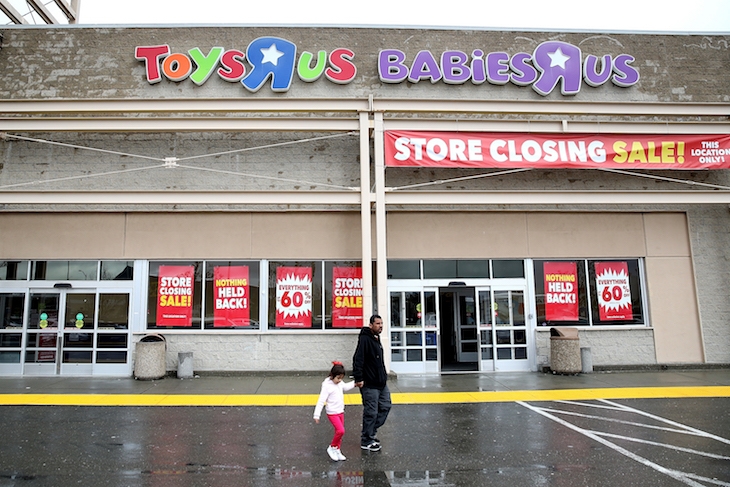I remember the arrival of Toys ‘R’ Us in Britain, because as a young banker
in 1984 I was tasked with devising a menu of exciting financial products to offer a brash American retailer that was clearly going to take a bite out of our sleepy — and in those days still Christmas-seasonal — domestic toy market. How we sneered at that childlike reversed R in the logotype; likewise the Guardian, commenting on insatiable demand for Cabbage Patch dolls, derided the chain’s huge stores as ‘-cathedrals to kiddie gratification’. But however tacky its image, this was the ultimate ‘economic disruptor’, to use The Spectator’s current favourite phrase: a business that utterly transformed its marketplace.
It did so by offering a cornucopia of toys at deep-discount prices — the more sought-after the item, the more aggressive the pricing — and brainwashing children into begging parents for more, all year round. To deploy another phrase from management science, it was the ‘category killer’ of its sector, rapidly building competitive advantage over rivals large and small. And whatever financial playthings we provided in support, they were not so toxic as to impede its onward march, trampling traditional shopkeepers along the way.
But now the category killer has itself been killed off by a combination of competitive might, bad finance and the power of the internet. First Toys ‘R’ Us was overtaken in sales volumes by Walmart, a discounter with colossal clout across the whole US retail sector; then it took on Amazon. When the online seller was still an up-and-comer back in 2000, it agreed to be a sales channel for selected Toy ‘R’ Us products: Amazon founder Jeff Bezos kept an empty chair at the negotiating table ‘for the customer’, to remind both sides of their ultimate purpose.
But Bezos (at least according to his biographer Brad Stone) is the most ruthless retail predator of all, and the deal ended in court in 2004 when Toys ‘R’ Us accused Amazon of breaking its terms. The following year Toys ‘R’ Us passed into the hands of private equity owners who loaded the company with billions of debt. A long decline began that is ending — ‘Toys R Bust’, as the Sun put it — with the closure of its last stores, 100 in the UK, this month. Amongst the bankrupt stock, liquidators will no doubt find stacks of Jurassic Park models to illustrate the Darwinian process by which such once-dominant species become extinct.
Beware the unintended
Why would a New York investment firm suddenly buy 5 per cent of Barclays, whose shares are among the limpest performers in the FTSE100? In order to generate a price spike and a quick profit, you might guess: but when the investor is Edward Bramson, through his firm Sherborne Investors, you’d probably be wrong. Bramson operates to a pattern of buying a significant stake in an underperformer, seeking a seat on its board, then demanding radical change in management and strategy. And that might not be a bad thing at Barclays, you’re thinking; but let’s remember that boardroom battles can have unintended consequences.
The example to bear in mind is that of another activist investor, Sir Chris Hohn — now better known for troublemaking at the London Stock Exchange — who in 2007 fired off a letter to the chairman of underperforming Dutch bank ABN Amro calling for its ‘break-up, spin-off, sale or merger’. That prompted a bid from Barclays capped by another from RBS, which won the contest but ruined itself as a result. Bramson won’t end up running Barclays, but who knows what turmoil he may stir.
The Facebook monster
I’m resigned to the idea of internet monsters using my browsing history to build a profile of my voting intentions, then selling it to the highest bidder. Indeed I’m curious how they categorise someone whose recent searches, reflected in pop-up ads, include retro spectacle frames and restaurants in Geneva, and who ‘likes’ pictures of golden retrievers. But here’s an anecdote I really do find sinister. I wanted to send an invitation to a friend who’s now a senior public official and whose home is so hidden that I once asked whether the family was in witness protection. I had lost the address, so I Googled as much of it as I could remember. It popped up instantly, with my friend’s full name, in a list of about a hundred home addresses of people in similarly sensitive jobs. It was in a Facebook posting by a subversive pressure group and it was clearly an invitation to mischief or worse. I can’t believe Facebook has never been asked to take it down, but they haven’t done so: it has been there for all to see for more than two years.
My Easter tip
Speaking of restaurants in Geneva, ‘the Swiss model’ may yet turn out to be the closest precedent for our final Brexit deal. It consists of multiple sector-by-sector agreements, subject to frequent renegotiation and falling well short of comprehensive ‘free trade’, plus continuing tensions over cross-border movement of people (the Swiss originally accepted free movement in exchange for partial single-market access, but voted in 2014 to limit immigration by quota). And Swiss-French border posts — solidly built, manned but not oppressive — may be exactly what our frontier with Ireland will have to look like in the end, despite all protestations to the contrary.
The canny Swiss, by the way, profit from the ‘hard border’ by charging 40 francs for a windscreen ‘vignette’ from any foreign motorist whose crossing takes them onto the Swiss motorways. That usually includes anyone following signs to and from Geneva airport. So here’s my tip if you’re heading that way to the French Alps this Easter. Traverse the city by the route to Annemasse and the Thônex border point, which avoids the motorways. Then spend your 40 francs (and more) on a slap-up lunch at the Chez Boubier Café de Paris, in rue du Mont-Blanc.







Comments